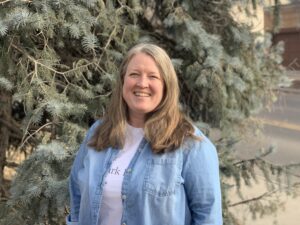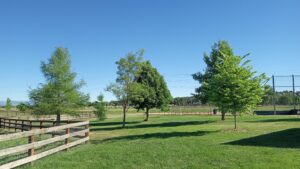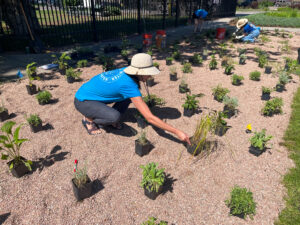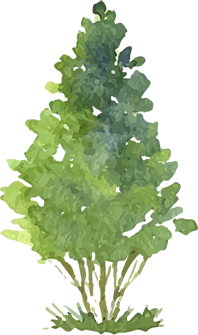Denver’s Urban Forest Public Survey

The City of Denver’s Urban Forest Strategic Planning process is an important and exciting opportunity for our community to plan holistically for the robust forest that we need now and into the future. The Community Survey is one way the City is engaging the many and diverse stakeholders in our communities to voice their wants, needs, and opinions that will inform the plan. Make your voice heard – complete the survey!
Curious about what The Park People thinks? Makes sense given our 5+ decades working in urban forestry. We’ve compiled our thoughts on the survey questions here:
- What do you think about trees?
Of course, we believe (and loads of research supports) the many benefits trees provide, including: beauty, cooling our buildings and communities, cleaning the air, absorbing storm water, reducing electric bills, improving property values, supporting health and safety, providing habitat for wildlife and food for pollinators, and slowing traffic speeds. So we’re making sure to voice our support loud and clear to the City. We also acknowledge that trees can be messy, that poorly planted trees can cause sidewalk damage, and that maintenance can be costly. But we know the pros vastly outweigh the cons, and those drawbacks can be mitigated.
- Where is it most important to plant additional trees in Denver?
It’s important to plant trees in most of the places listed on the survey. In a world of limited resources, we’d prioritize funds in areas that have little shade and few trees today, along streets, and at private yards/houses (and this is indeed largely what The Park People does with the resources we have). We’d also focus more trees at schools and parks – public spaces with a lot of people and that are natural community cooling centers. Some of us would also focus on strategic plantings in parking lots and in industrial areas (some of the hottest areas given all the paved surface) and at new development/construction projects (where there’s a blank slate opportunity to plan for an integrated tree canopy).
- Should healthy trees on private property be protected from removal through city regulation?
Like any healthy community, there’s diversity of opinion among us Park People. Many of us agree that there should be protections for especially large trees and historically significant trees, and some of us feel that maintaining tree canopy on commercial and multifamily properties is critical to mitigate the higher heat retention of larger buildings and help denser, paved areas of our city stay cool. Many also feel educating and encouraging protection on single family residential properties is important but that the strongest protections (prohibitive regulation) might be an overreach.
Protection does not necessarily mean complete prohibition of removing trees. One potential approach might be that in situations where private property trees are removed, an offset would be required wherein new trees equal to or greater than the diameter of the removed trees would be planted, e.g. if the tree was 12” in diameter new trees totaling the 12” diameter would need to be planted either on the property, close by, or at a park.
- Public infrastructure includes facilities intended for public use such as transportation and utilities. Do you believe trees are an important aspect of public infrastructure and should be given equal consideration?
We feel confident that the City won’t go tearing up sidewalks or removing electric service from our neighborhoods. So we believe that Yes, trees should be given equal consideration as an important aspect of public infrastructure and that more holistic planning will incorporate trees in an integrated, complimentary way. Trees are essential urban green infrastructure – the air conditioners for our warming city, the natural sponges during rainstorms – and they deserve to be planned for, invested in, and cared for. No more tree-sidewalk conflicts… No more desolate concrete canyons in our growing city… No more trees as an afterthought!
- The City of Denver has limited resources for planting and maintaining trees in the public right-of-way (the area between the curb and property line that can include sidewalks, trees, and other amenities). What would you personally do to help protect, maintain and grow public street trees in Denver? (Please select all that apply.)
The Park People hopes that most residents would be willing to water street trees adjacent to their property (checkbox 1) and that many might volunteer their time (checkbox 3) and attend education opportunities (checkbox 9).
We are honored to be named in the survey alongside other partners of the City and know that additional financial support for nonprofit programs and projects like ours would be a cost-effective and community-oriented way to plant and steward our community’s street trees (checkbox 7).
Many of us Park People are writing in to suggest prioritization of public funds to support maintenance and hazard tree pruning and removal for low-income households (“Do you have other suggestions we should explore?” field at bottom of checklist). Got any other important thoughts or creative ideas? Want to see a new tax on marijuana to help fund tree growing or harness the power of squirrel labor to prune small branches on mature trees? Type it in; let’s find solutions!
Some Park People would support an assessment or impact fee on new development to support long term maintenance of the urban forest (checkbox 6).
While having the City take over routine or hazardous tree maintenance would help provide good outcomes, we anticipate this would be an enormous cost and know that our city faces many important needs, so would prioritize more cost-efficient, strategic approaches to supporting the care of our urban forest (probably not checkboxes 2 and 4).
We worry that an incentive for planting and caring for street trees devalues trees and may not be a sustainable approach to stewardship (no on checkbox 5).
- Do you know about the following city ordinance and programs to protect and increase trees? (Please select all that apply.)
This answer is all your own. We hope you’re familiar with The Park People’s Denver Digs Trees program (checkbox 3), but if you’re not, find out more about how you can get free and affordable street and yard trees here. We’re also a nonprofit partner of the City’s Office of Climate Action, Sustainability and Resiliency (CASR), planting trees on private property through their Equitable Community Tree Planting Initiative (checkbox 4), and we partner with the City in different ways through the Be A Smart Ash (BASA) and the tree planting and Forestry Neighborhood Enhancement (FNE) programs (checkboxes 1 and 2).
- What is your hope for the future of the urban forest in Denver?
We hope for (and work toward!) a robust, healthy forest cooling, protecting, and bringing beauty to Denver’s neighborhoods. This forest is dense (where appropriate), diverse (in species and age), drought resilient, and well maintained. Our whole community understands and values the role that trees play in our urban ecosystem, and a rich array of people and partners are playing a part in nurturing these critical resources in our forested city.
- Do you live, work, and play in Denver? (Please select all that apply.)
This answer is all your own, and you can add any other ways you enjoy and benefit from our city and its forest, e.g. “I attend events, concerts, special attractions.”
Thanks in advance for taking the time to share your thoughts with the City. Hearing from you will help create the best outcome for our community forest!
Categories
Archives
Support us with a Donation
Related Posts

Arborist’s Corner: Show Us Your Root Flare

Arborist’s Corner: The Importance of Biodiversity in the Landscape



